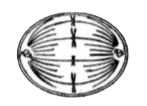Complete Solutions to SECTION-I of chapter SAMPLE QUESTION PAPER 4 of Class 10 book with complete answers and questions
| Class 10 | BIOLOGY |
| Chapter | SAMPLE QUESTION PAPER 4 |
| OSWAL | SECTION-I |
| Number Of Questions | 24 |
| Academic Year | 2023-24 |
Give the specific function of:
(i) Centrosome
(ii) Stoma
(iii) Transpiration
(iv) Ureter
(v) Vitreous humour
View SolutionThe diagram given below represents a stage during cell division
Study the same and answer the questions that follow :

Identify whether it is a plant cell or an animal cell। Give a reason in support of your answer.
View SolutionThe diagram below represents a process in plants. The setup was placed in bright sunlight. Answer the following questions :

Explain the term 'Guttation'
View SolutionWrite in correct logical sequence without changing the first term
Destarched plant, iodine added, washed in water, a leat boiled in alcohol, placed in sunlight. (Testing for presence of starch).
View SolutionExplain the term : Photolysis
View SolutionDefine the following:
Diapedesis
View SolutionExplain briefly :
Pulse.
View SolutionChoose the odd one out of the following set of terms given and name the category to which the others belong:
(i) Phosphate, RNA, Sugar, Nitrogenous base.
(ii) Urethra, uterus, urinary bladder, ureter.
(iii) Cyton, Photon, Axon, Dendron.
(iv) Haemoglobin, glucagon, iodopsin, rhodopsin.
(v) Dendrites, Medullary Sheath, Axon, Spinal cord.
View SolutionGive one point of difference between the following pair on the basis of what is indicated in bracket.
Medulla oblongata and cerebellum (function).
View SolutionDifferentiate between the following pairs on the basis of what is indicated within the brackets:
Artery and vein (direction of blood flow)
View SolutionBicuspid and tricuspid valves are closed during
View SolutionWhich one of the following is the correct difference between rod cells and cone cells of our retina ?
View SolutionWith reference to the functioning of the eye, answer the questions that follow :
What is the shape of the lens during :
(a) near vision (b) distant vision ?
View SolutionGive biological reason for the following:
Throat infections could lead to ear infections.
View SolutionGive biological reasons for the following :
The hand automatically shows the direction to turn a cycle without thinking.
View SolutionComment upon the following:
The urine is slightly thicker in summer than in winter.
View SolutionWhy is pituitary gland called the "master gland" ?
View SolutionGive biological reason for the following statement: Some women have facial hair like beard and moustache.
View SolutionThe type of cell division which occurs in the cells of the reproductive organs.
View SolutionCytoplasmic organelle that helps in the manufacture of starch.
View SolutionName the following :
The phenomenon by which living or dead plant cells absorb water by surface attraction .
View SolutionName the following :
The process of conversion of ADP into ATP during photosynthesis.
View SolutionName the knot like mass of blood capillaries inside the Bowman's capsule.
View SolutionCorrect the following statements by changing the underlined words:
(i) Normal pale yellow colour of the urine is due to the presence of the pigment Melanin.
(ii) The outermost layer of meninges is Piamater.
(iii) The cell sap of root hairs is Hypotonic.
(iv) Xylem transports starch from the leaves to all parts of the plant body.
(v) Nitrogen bonds are present between the complementary nitrogen bases of DNA.
View Solution
SECTION-I questions and complete solutions for chapter SAMPLE QUESTION PAPER 4 of EVERGREEN BIOLOGY (ENGLISH) of Class 10